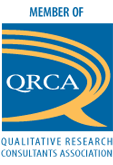The definition of a hallmark: A distinguishing characteristic, trait or feature. A hallmark allows the observer to tell the difference between something genuine and something that simply “looks good”.
Clients choose moderators for projects based on a number of factors. To be sure, personality is a key factor as well as the ease with which the moderator gets along with the client team. If a client has used them before, the moderator might be asked to return as the needs of the client were served in the past and there is a desire to repeat the positive experience with the next project. Sometimes a moderator is chosen as a match for gender, race, age, or because of a specific product or research expertise.
When a moderator is new to a client team, they are observed in the fishbowl environment of a one way mirror, cameras and audio tapes while working with a set of respondents who are all strangers. In less than two hours, the moderator is charged with creating an environment of trust, covering 2-5 topic areas, showing stimuli, engaging all respondents to give more than top of mind comments and helping the client team see the internal thinking of a segment of a target market. The good moderators make it look easy. The poor ones make a two hour group seem as though the passage of time has been stopped.
So, when one is behind the mirror, what are the hallmarks of a good moderator – what is the proof that successful management of group dynamics is going on, allowing an environment to exist that permits respondents to answer fully and with limited shielding of responses?
Below is a set of “hallmarks” for good moderators. “Yes” is the right answer for most of the questions below, but there are three where the correct answer is “no.” Those three would be hallmarks of a poor moderator.
Did the moderator:
- Flow from point to point without abrupt shifts?
- Keep the discussion on topic and off tangents?
- Probe for clarity but knew when to stop probing?
- Maintain unconditional positive regard (UPR) for respondents and stay neutral in lines of questions?
- Ask questions that opened up respondents to relate specifics and details?
- Put words in the mouths of respondents?
- Establish genuine rapport at outset and maintain it for whole QRE?
- Make analytical summarizing statements while moderating?
- Read the room and “stayed with respondents” and not with paper or own ego?
- Attend to non-verbal communications?
- Give clear grounds rules for participation?
- Give full disclosers about mirrors, mics, and observers?
- Conduct “serial interviewing” so everyone always had to answer every question?
- Use a variety of research tools and techniques?
- Keep a steady pace – moving forward – avoiding lags in the discussion?
- Provide logic and linking skills for respondents and observers?
- Listen to respondents rather than informing respondents?
- Vary tone, pitch, speed, and volume of own voice while moderating?
- Change location/ body position from time to time while moderating?
- Give clear instructions for respondent activities?
- Let respondents do the work – did not help by giving clues to desired answers?
- Ask short questions, one at a time?
- Include everyone in the discussion?
- Know when to move on without a note from backroom?
- Practice “invisible leadership” skills?
On the above hallmark list, the ones that should be avoided are numbers six, eight, and thirteen since these qualities do not promote good discussion or data collection.
If you are a moderator, how many are you living the “yes” implied for twenty-two of the factors on the list above? If you are a client, how many of the moderators you hire would find it easy to do twenty-two of the above tasks and step adroitly away from three with knowledge?
What are hallmarks of a good moderator? Armed with the list above, it will be easy to spot the genuine article through a one way mirror.
by Naomi Henderson

 QRCA is a not-for-profit association of consultants involved in the design and implementation of qualitative research — focus groups, in-depth interviews, in-context and observational research, and more.
QRCA is a not-for-profit association of consultants involved in the design and implementation of qualitative research — focus groups, in-depth interviews, in-context and observational research, and more.